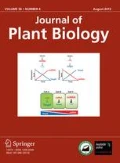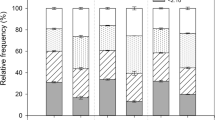Abstract
Variation in resource allocation to clonal growth versus sexual reproduction suggests that plants have different adaptive strategies in response to environmental conditions such as nutrient availability and soil moisture. Seeds of P. chinense might play an important role in expanding its established populations. We hypothesize that an early successional perennial plant Penthorum chinense Pursh with many seeds and small rhizomes does not increase its allocation to rhizome propagules and/or decrease its allocation to seeds under sufficient nutrient content or moisture conditions, unlike many other perennials. We performed mesocosm experiments to understand how P. chinense could alter resource allocation to rhizomes and seeds under experimental manipulation of water and nutrient availability. Like many perennials, P. chinense contained more rhizome dry mass and rhizome mass fraction under favorable nutrient content condition than with relatively low nutrient levels. However, P. chinense did not decrease its allocation to seeds under sufficient nutrient condition. It did not change its allocation to rhizome propagules or seeds under high moisture level either, unlike other perennials. These results suggest that both rhizomes and seeds of P. chinense might be important for expanding its established populations.
Similar content being viewed by others
References
Abrahamson WG (1979) Patterns of resource allocation in wildflower populations of fields and woods. Am J Bot 66:71–79
Baker HG (1974) The evolution of weeds. Annu Rev Ecol Syst 5:1–24
Bai W, Sun X, Wang Z, Li L (2009) Nitrogen addition and rhizome severing modify clonal growth and reproductive modes of Leymus chinensis population. Plant Ecol 205:13–21
Boedeltje G, Ozinga WA, Prinzing A (2008) The trade-off between vegetative and generative reproduction among angiosperms influences regional hydrochorous propagule pressure. Global Ecol Biogeogr 17:50–58
Choo YH, Nam JM, Kim JH, Kim JG (2015) Advantages of amphicarpy of Persicaria thunbergii in the early life history. Aquat Bot 121:33–38
Damman H, Cain ML (1998) Population growth and viability analyses of the clonal woodland herb, Asarum canadense. J Ecol 86:13–26
Eriksson O (1985) Reproduction and clonal growth in Potentilla anserina L. (Rosaceae): the relation between growth form and dry weight allocation. Oecologia 66:378–380
Gehring J.L, Linhart YB (1993) Sexual dimorphisms and response to low resources in the dioecious plant Silene latifolia (Caryophyllaceae). Int J Plant Sci 154:152–162
Grant V (1981) Plant speciation, 2nd Ed, New York, Columbia University Press, 432p
Hutchings MJ, Mogie M (1990) The spatial structure of clonal plants: control and consequences. In: Clonal growth in plants: regulation and function (van Groenedael J, de Kroon H, eds) The Hague, SPB, pp 57–78
Ikeda H, Itoh K (2001) Germination and water dispersal of seeds from a threatened plant species Penthorum chinense. Ecol Res 16:99–106
Kang HK, Ohkuro T, Ide M (2003) Vegetation structure and environmental characteristics of native habitats for a vulnerable plant species Penthorum chinense–a focus on the southern part in Ibaraki, Japan. J Korean Inst Landsc Archit 31:83–93
Kaydan D, Yagmur M (2008) Germination, seedling growth and relative water content of shoot in different seed sizes of triticale under osmotic stress of water and NaCl. Afr J Biotechnol 7:2862–2868
Khurana E, Singh JS (2004) Germination and seedling growth of five tree species from tropical dry forest in relation to water stress: impact of seed size. J Trop Ecol 20:385–396
Kimura Y, Terazaki F, Ohno K, Tanahasi A (2000) Possibility of restoration of Penthorum chinense Pursh by using soil seed bank. Jpn J Conserv Ecol 5:197–204
Kiviniemi K (2002) Population dynamics of Agrimonia eupatoria and Geum rivale, two perennial grassland species. Plant Ecol 159:153–169
Klimes L, Klimesova J, Hendriks R, van Groenendael J (1997) Clonal plant architecture: a comparative analysis of form and function. In: The Ecology and Evolution of Clonal Plants. Backhuys Publishers, Leiden, pp 1–29
Leishman MR, Westoby M (1994) The role of seed size in seedling establishment in dry soil conditions–experimental evidence from semi-arid species. J Ecol 82:249–258
Li BO, Shibuya T, Yogo Y, Hara T, Yokozawa M (2001) Interclonal differences, plasticity and trade-offs of life history traits of Cyperus esculentus in relation to water availability. Plant Spec Biol 16:193–207
Liu F, Wu WY, Wan T, Wang QF, Cheng Y, Li W (2013) Temporal variation of resource allocation between sexual and asexual structures in response to nutrient and water stress in a floatingleaved plant. J Plant Ecol 6:499–505
Loehle C (1987) Partitioning of reproductive effort in clonal plants: a benefitcost model. Oikos 49:199–208
Mal TK, Lovett-Doust J (2005) Phenotypic plasticity in vegetative and reproductive traits in an invasive weed, Lythrum salicaria (Lythraceae), in response to soil moisture. Am J Bot 92:819–825
Marino PC, Eisenberg RM, Cornell HV (1997) Influence of sunlight and soil nutrients on clonal growth and sexual reproduction of the understory perennial herb Sanguinaria canadensis L. J Torrey Bot Soc 124:219–227
Nicholls AM (2011) Size-dependent analysis of allocation to sexual and clonal reproduction in Penthorum sedoides under contrasting nutrient levels. Int J Plant Sci 172:1077–1086
Obeso JR (2002) The costs of reproduction in plants. New Phytol 155:321–348
Ogden J (1974) The reproductive strategy of higher plants: II. The reproductive strategy of Tussilago Farfara L. J Ecol 62:291–324
Philbrick CT, Les DH (1996) Evolution of aquatic angiosperm reproductive systems. What is the balance between sexual and asexual reproduction in aquatic angiosperms? Bioscience 46:813–826
Pluess AR, Stocklin J (2005) The importance of population origin and environment on clonal and sexual reproduction in the alpine plant Geum reptans. Funct Ecol 19:228–237
Radosevich SR, Holt JS, Ghersa CM (1996) Weeds Ecology: Implications for Management, 2nd ed, John Wiley and Sons, New York
Ronsheim ML (1996) Evidence against a frequency-dependent advantage for sexual reproduction in Allium vineale. Am Nat 147:718–734
Ronsheim ML, Bever JD (2000) Genetic variation and evolutionary trade-offs for sexual and asexual reproductive modes in Allium vineale (Liliaceae). Am J Bot 87:1769–1777
Sarukhan J (1974) Studies on plant demography: Ranunculus repens L., R. bulbosus L. and R. acris L. 2. Reproductive strategies and seed population dynamics. J Ecol 62:151–177
Shipley B, Keddy PA (1988) The relationship between relative growth rate and sensitivity to nutrient stress in twenty-eight species of emergent macrophytes. J Ecol 76:1101–1110
Silander JA (1985) Microevolution in clonal plants. In: Population Biology and Evolution of Clonal Organisms. Yale University Press, London, pp 107–152
Thomas AG, Dale HM (1975) The role of seed reproduction in the dynamics of established populations of Hieracium floribundum and a comparison with that of vegetative reproduction. Can J Botany 53:3022–3031
Turner CE (1988) Ecology of invasions by weeds. In: Weed Management in Agroecosystem. Ecological Approaches CRC Press, Florida, pp 41–55
van Andel J, Vera F (1977) Reproductive allocation in Senecio sylvaticus and Chamaenerion angustifolium in relation to mineral nutrition. J Ecol 65:747–758
van Kleunen M, Fischer M, Schmid B (2002) Experimental lifehistory evolution: selection on the allocation to sexual reproduction and its plasticity in a clonal plant. Evolution 56:2168–2177
Wang Z, Xu A, Zhu T (2008) Plasticity in bud demography of a rhizomatous clonal plant Leymus chinensis L. in response to soil water status. J Plant Biol 51:102–107
Wulff RD (1986) Seed size variation in Desmodium Paniculatum: II. Effects on seedling growth and physiological performance. J Ecol 74:99–114
Yang YY, Kim JG (2016) The optimal balance between sexual and asexual reproduction in variable environments: a systematic review. J Ecol Environ 40:12
Yang YY, Kim JG (2017) The life history strategy of Penthorum chinense: implication for the restoration of early successional species. Flora 233:109–117
Yonemura S (2000) Preliminary study on restoration of the vulnerable plant species Penthorum chinense. J Jpn Soc Reveget Tech 25:317–320
Zangerl AR, Bazzaz FA (1983) Responses of an early and a late successional species of Polygonum to variations in resource availability. Oecologia 56:397–404
Zhang Y, Zhang D (2007) Asexual and sexual reproductive strategies in clonal plants. Front Biol China 2:256–262
Author information
Authors and Affiliations
Corresponding author
Rights and permissions
About this article
Cite this article
Yang, Y.Y., Kim, J.G. Changes in Reproductive Strategy of an Early Successional Species Penthorum chinense in Response to Nutrient and Moisture Levels. J. Plant Biol. 62, 103–108 (2019). https://doi.org/10.1007/s12374-018-0334-x
Received:
Accepted:
Published:
Issue Date:
DOI: https://doi.org/10.1007/s12374-018-0334-x




